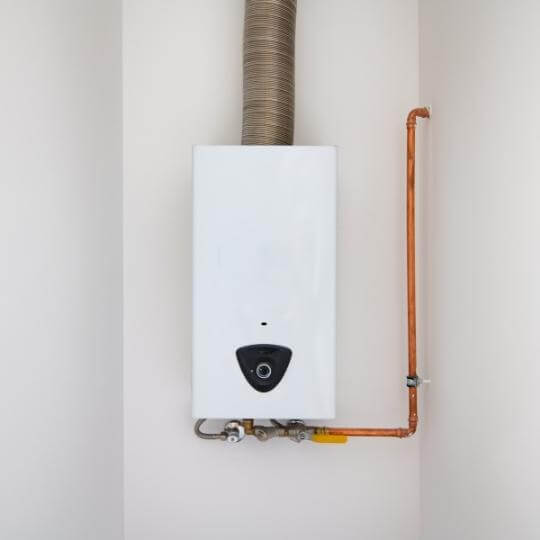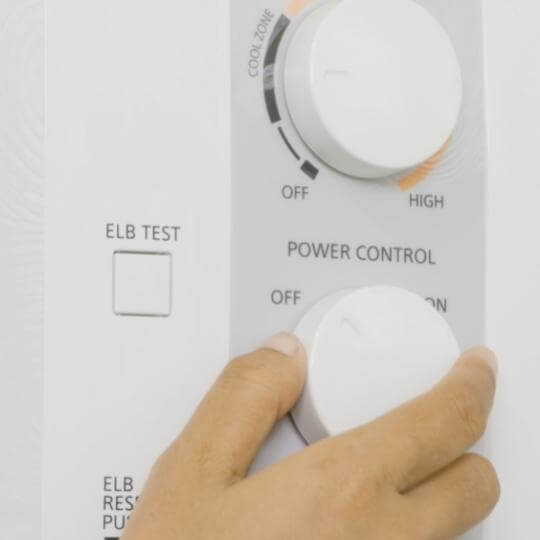How to flush a tankless water heater, gas or electric, yourself? Which products to use? Find out on this link!
Tankless water heaters tend to, due to hard water, build up minerals such as calcium and magnesium, along with other debris relatively quickly compared to regular, tank units.
Sediment buildup can easily mess up the optimal performance of your tankless water heater – narrow or completely clog water passages. When this happens, you’ll have no other choice but to swap your tankless water heater with a brand-new unit.
Knowing the price of an average tankless water heater, would you even consider taking this risk? That’s what we thought! Every manufacturer recommends having your tankless water heater regularly cleaned and maintained with proper products.

You will learn how to flush a tankless water heater (gas or electric) without scrambling and keep the unit running at its peak performance.
Not only that, but we are also giving you tips on which solutions to use, making a comparison between these solutions, and more!
How Often Should You Have Your Tankless Water Heater Flushed?
Tankless water heaters should be flushed once per year, except for tankless water heaters installed in hard water areas. If you live in an area like this, you might want to flush your tankless water heater every 6 to 10 months. Don’t know what is the hardness of the water in your area? Check this hard water map or consult your city government.
Flushing a Tankless Water Heater – Safety Precautions
- Be very careful when flushing your tankless water heater, otherwise hot water from the system can burn you.
- Use either food grade, not regular, vinegar or chemicals recommended by the heater’s manufacturer for this task.
How to Flush a Tankless Water Heater?

To perform a DIY tankless water heater flush, follow the steps listed below.
Flushing a Gas Tankless Water Heater
- Collect all the necessary supplies. For this task, you are going to need a screwdriver, adjustable wrench, 5-gallon bucket, 4 gallons of white vinegar/de-liming solution/DIY tankless water heater flush kit, submersible pump, 6-ft washing machine hoses, and non-contact voltage tester.
- Disconnect your tankless water heater from the electrical power, water and gas supply. Once you’ve disconnected the unit from the electrical power, use a non-contact voltage tester to make sure it’s safe to proceed. Locate the color-coded (yellow, blue, and silver) handles under the unit meant to shut off your tankless water heater’s water and gas supply. Turn them to a position so they are not in line with the pipe.
- Open the hot water pressure relief valve. Locate the hot water line, place a bucket under it, slowly start opening the pressure relief valve, and hot water will start coming out of the system right into the bucket. Empty the bucket.
- Connect washing machine hoses to a submersible pump and the cold water service port.
- Connect another hose to the hot water service port and submerge the other end of the hose into the bucket.
- Submerge the pump into a bucket filled with 4 gallons of undiluted, food-grade white vinegar or use a DIY tankless water heater flush kit.
- Open cold and hot service ports.
- Turn the submersible pump on. Then, leave it there for the next 60 minutes. This will allow the vinegar/water heater flush solution to circulate through the unit and flush out limescale buildups. If your submersible pump operates at a rate lower than 4-gallons/minute, leave it to sit for more than 60 minutes.
- Turn off the pump, empty the bucket, remove the attached hoses, close the cold water service port and open the cold water valve. This should flush out any remaining vinegar into the bucket. Wait for 10 minutes, then close the cold water valve.
- Flush out any remaining sediment from the cold water inlet filter, replace the filter, and open the cold water valve again.
- Connect your tankless water heater to water and gas supply and electrical power.
Flushing an Electric Tankless Water Heater
- Turn off the power coming to your electric tankless water heater.
- To prevent water from coming into the unit, turn off the cold water shut-off valve.
- Open several faucets in your home to completely drain the water from the tankless heater, then turn off the hot water shut-off valve.
- Use a non-contact voltage tester to make sure no electricity is reaching your tankless water heater.
- Remove the electrical heating elements using a screwdriver, then loosen the brass top of the tankless water heater using a wrench and rotating it counterclockwise.
- Now the heating element is taken off, you can inspect whether there are any cracked parts and if they should be replaced.
- Fill the unit’s copper chambers with either tankless water heater descaler or vinegar and throw in the heating elements inside as well. Wait for the next hour and a half to two hours maximum.
- Drain the liquid from the chambers, get the heating elements back in place, then secure the wires to the top with a screwdriver.
- Open the cold water shut-off valve and fill the tank with water to flush out any residual vinegar. At the same time, double-check whether the tank may be leaking. If not, please proceed, otherwise, you’ll have to contact a professional who will advise whether it is possible to fix the leakage.
- Open the hot water shut-off valve and several hot water faucets to remove any vinegar leftovers from the system. Let the water run for about 5 minutes.
- Locate the cold water inlet filter, then remove it and flush out any debris and sediment from the housing, dry it, and put it back into place.
Tankless Water Heater Descaler vs Vinegar
- Kit requires 2 gallons of white vinegar***...
- Helps maintain the performance and extend the...
- Includes 1/8 HP Utility Pump, 6 Ft Color...
To flush a tankless water heater, you can either use a descaler or vinegar. Food-grade vinegar is, on average, a cheaper and more eco-friendly option.
However, a tankless water heater descaler appears to be more efficient when it comes to removing nasty buildups from tankless water heaters in hard water areas. A product like this can restore the unit’s heating efficiency and water flow.
How Long Does a Tankless Water Heater Flush Take?
Flushing a tankless water heater takes 1 hour (for gas water heaters) to 2 hours maximum (for electric water heaters). However, the flush may take slightly longer the first time you are doing it.
If you are still not sure what is difference between electric or gas heaters check it here.
Bonus Tankless Water Heater Maintenance Tips

Flushing your tankless water heater is important, yet, there are several other things you might want to do to make the unit work like clockwork.
1. Clean the Air Filter
Your tankless water heater comes with an air filter you should clean regularly. Remove the air filter from the unit, mix some warm water and soap in a bucket, and dip a soft brush in the bucket. Then, use the brush to remove any sediments from the filter. Rinse well and dry it with a cloth before taking it back. This should restore proper airflow within your tankless water heater.
2. Clean the Water Filter
A screen on your tankless water heater traps dust, dirt, and debris like crazy! These sediments can, after a while, mess up with the proper functionality of the unit (f.e. restrict the hot water supply). Cut off the water supply to the unit, remove the water filter, wash it with some warm, soapy water, dry it, and re-install it.
3. Clean the Tank
Although everyone calls it tankless, a tankless water heater still comes with a tank. And if you don’t maintain the outside of the tank properly, dust and debris may start building up. Mixed with water, these buildups can make the tank go rusty, which is why you should occasionally wipe off any particles from its surface. Do not wipe down the tank before turning the power and water supply off the tankless water heater.
Summary
Now that you know why tankless water heater maintenance is so important (so much you can even extend the life of the unit to shocking 25 years), we believe you’ll never forget to flush out the unit again. Also, now that you know how to flush a tankless water heater, you’ll never need a tankless water heater service again. If you find this post helpful, check out the rest of our guides here!

Michael Davis is a heating & plumbing expert who currently works as independent contractor in SC. He also writes for Plumbertip.
For almost 10 years he worked on various plumbing tasks across South Carolina.




